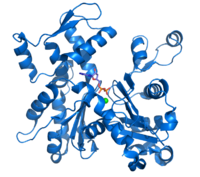
Photo from wikipedia
The measurement of local mechanical properties of living cells by nano/micro indentation relies on the foundational assumption of locally isotropic cellular deformation. As a consequence of assumed isotropy, the cell… Click to show full abstract
The measurement of local mechanical properties of living cells by nano/micro indentation relies on the foundational assumption of locally isotropic cellular deformation. As a consequence of assumed isotropy, the cell membrane and underlying cytoskeleton are expected to locally deform axisymmetrically when indented by a spherical tip. Here, we directly observe the local geometry of deformation of membrane and cytoskeleton of different living adherent cells during nanoindentation with the integrated Atomic Force (AFM) and spinning disk confocal (SDC) microscope. We show that the presence of the perinuclear actin cap (apical stress fibers), such as those encountered in cells subject to physiological forces, causes a strongly non-axisymmetric membrane deformation during indentation reflecting local mechanical anisotropy. In contrast, axisymmetric membrane deformation reflecting mechanical isotropy was found in cells without actin cap: cancerous cells MDA-MB-231, which naturally lack the actin cap, and NIH 3T3 cells in which the actin cap is disrupted by latrunculin A. Careful studies were undertaken to quantify the effect of the live cell fluorescent stains on the measured mechanical properties. Using finite element computations and the numerical analysis, we explored the capability of one of the simplest anisotropic models – transverse isotropy model with three local mechanical parameters (longitudinal and transverse modulus and planar shear modulus) – to capture the observed non-axisymmetric deformation. These results help identifying which cell types are likely to exhibit non-isotropic properties, how to measure and quantify cellular deformation during AFM indentation using live cell stains and SDC, and suggest modelling guidelines to recover quantitative estimates of the mechanical properties of living cells.
Journal Title: Scientific Reports
Year Published: 2019
Link to full text (if available)
Share on Social Media: Sign Up to like & get
recommendations!